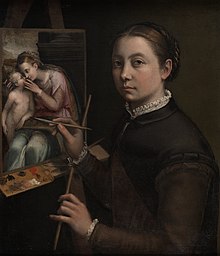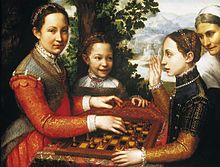
Back صفونيسبا أنجيسولا Arabic صفونيسبا انجيسولا ARZ Sofonisba Anguissola BCL Сафанісба Ангісола Byelorussian Софонизба Ангуисола Bulgarian Sofonisba Anguissola Breton Sofonisba Anguissola Catalan Sofonisba Anguissola Czech Sofonisba Anguissola Welsh Sofonisba Anguissola Danish
Sofonisba Anguissola | |
|---|---|
 Self-Portrait, 1556, Lancut Museum, Poland | |
| Born | c. 1532 |
| Died | 16 November 1625 (aged 93) |
| Nationality | Italian |
| Education | Bernardino Campi, Bernardino Gatti |
| Known for | Portrait painting, drawing |
| Movement | Late Renaissance |
| Patron(s) | Philip II of Spain |
| Signature | |
 | |

Sofonisba Anguissola (c. 1532[1] – 16 November 1625), also known as Sophonisba Angussola or Sophonisba Anguisciola,[2][3] was an Italian Renaissance painter born in Cremona to a relatively poor noble family. She received a well-rounded education that included the fine arts, and her apprenticeship with local painters set a precedent for women to be accepted as students of art. As a young woman, Anguissola traveled to Rome where she was introduced to Michelangelo, who immediately recognized her talent, and to Milan, where she painted the Duke of Alba. The Spanish queen, Elizabeth of Valois, was a keen amateur painter and in 1559 Anguissola was recruited to go to Madrid as her tutor, with the rank of lady-in-waiting. She later became an official court painter to the king, Philip II, and adapted her style to the more formal requirements of official portraits for the Spanish court. After the queen's death, Philip helped arrange an aristocratic marriage for her. She moved to Sicily, and later Pisa and Genoa, where she continued to practice as a leading portrait painter.
Her most distinctive and attractive paintings are her portraits of herself and her family, which she painted before she moved to the Spanish court. In particular, her depictions of children were fresh and closely observed. At the Spanish court she painted formal state portraits in the prevailing official style, as one of the first, and most successful, of the relatively few female court painters. Later in her life she also painted religious subjects, although many of her religious paintings have been lost. In 1625, she died at age 93 in Palermo.
Anguissola's example, as much as her oeuvre, had a lasting influence on subsequent generations of artists, and her great success opened the way for larger numbers of women to pursue serious careers as artists. Her paintings can be seen at galleries in Boston (Isabella Stewart Gardner Museum), Milwaukee (Milwaukee Art Museum), Bergamo, Brescia, Budapest, Madrid (Museo del Prado), Naples, and Siena, and at the Uffizi Gallery in Florence.
Her contemporary Giorgio Vasari wrote that Anguissola "has shown greater application and better grace than any other woman of our age in her endeavors at drawing; she has thus succeeded not only in drawing, coloring and painting from nature, and copying excellently from others, but by herself has created rare and very beautiful paintings."[4]
© MMXXIII Rich X Search. We shall prevail. All rights reserved. Rich X Search